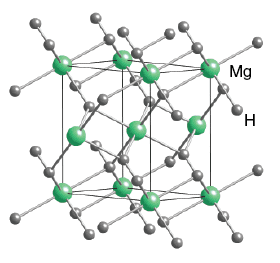Formula MgH2 Density 1.45 g/cm³ Appearance white crystals | Molar mass 26.3209 g/mol Melting point 327 °C | |
 | ||
Magnesium hydride is the chemical compound MgH2, making it an alkaline earth hydride. It contains 7.66% by weight of hydrogen and has been studied as a potential hydrogen storage medium.
Contents
Preparation
In 1951 preparation from the elements was first reported involving direct hydrogenation of Mg metal at high pressure and temperature (200 atmospheres, 500 °C) with MgI2 catalyst:
Mg + H2 → MgH2Lower temperature production from Mg and H2 using nano crystalline Mg produced in ball mills has been investigated. Other preparations include:
Structure and bonding
The room temperature form α-MgH2 has a rutile structure, which is similar to TiO2 There are at least four high pressure forms: γ-MgH2 with α-PbO2 structure, cubic β-MgH2 with Pa-3 space group, orthorhombic HP1 with Pbc21 space group and orthorhombic HP2 with Pnma space group. Additionally a non stoichiometricetric MgH(2-δ) has been characterised, but this appears to exist only for very small particles
(bulk MgH2 is essentially stoichiometric, as it can only accommodate very low concentrations of H vacancies).
The bonding in the rutile form is sometimes described as being partially covalent in nature rather than purely ionic; charge density determination by synchrotron x-ray diffraction indicates that the magnesium atom is fully ionised and spherical in shape and the hydride ion is elongated. Molecular forms of magnesium hydride, MgH, MgH2, Mg2H, Mg2H2, Mg2H3, and Mg2H4 molecules identified by their vibrational spectra have been found in matrix isolated samples at below 10 K, formed following laser ablation of magnesium in the presence of hydrogen. The Mg2H4 molecule has a bridged structure analogous to dimeric aluminium hydride, Al2H6.
Reactions
MgH2 readily reacts with water to form hydrogen gas:
MgH2 + 2 H2O → 2 H2 + Mg(OH)2At 287 °C it decomposes to produce H2 at 1 bar pressure, the high temperature required is seen as a limitation in the use of MgH2 as a reversible hydrogen storage medium:
MgH2 → Mg + H2Potential use for hydrogen storage
Its potential as a reversible "storage" medium for hydrogen has led to interest in improving the hydrogenation and dehydrogenation reaction kinetics. This can be partially achieved by doping or by reducing the particle size using ball milling. An alternative approach under investigation is the production of a pumpable slurry of MgH2 which is safe to handle and releases H2 by reaction with water, with reprocessing of the Mg(OH)2 into MgH2.[1] An application (yet to be examined) for a US Patent (US 2010/0163434 A1) [2] has been made in respect of a hydrogen energy storage system using laser excitation to assist desorption of hydrogen gas from magnesium hydride.
